Sketch the bond moments and resultant dipole moments in cis and trans forms of C2H2Cl2
To solve the problem of sketching the bond moments and resultant dipole moments in the cis and trans forms of C2H2Cl2, we will follow these steps:
Step 1: Draw the Structures
1. Cis Form: In the cis form, the two chlorine atoms are on the same side of the double bond. The structure can be represented as:
HCl C=CHCl
2. Trans Form: In the trans form, the two chlorine atoms are on opposite sides of the double bond. The structure can be represented as:
ClH C=CHCl
Step 2: Identify Bond Moments
- Bond Moments: The bond moment is a vector quantity that points from the less electronegative atom to the more electronegative atom. In this case, chlorine (Cl) is more electronegative than carbon (C), and carbon is more electronegative than hydrogen (H).
1. Cis Form:
- For the C-Cl bonds, the dipole moments will point towards the chlorine atoms.
- For the C-H bonds, the dipole moments will point towards the carbon atoms.
- The bond moments can be represented as arrows pointing towards Cl from C and towards C from H.
2. Trans Form:
- Similar to the cis form, the C-Cl bond moments will point towards the chlorine atoms.
- The C-H bond moments will point towards the carbon atoms.
Step 3: Resultant Dipole Moment
1. Cis Form:
- The dipole moments from the two C-Cl bonds will add together since they are in the same direction (upwards).
- The resultant dipole moment will not cancel out, resulting in a net dipole moment pointing upwards.
2. Trans Form:
- The dipole moments from the two C-Cl bonds will point in opposite directions.
- These dipole moments will cancel each other out, resulting in a net dipole moment of zero.
Final Summary
- Cis \( C_2H_2Cl_2 \): Has a net dipole moment because the bond moments do not cancel out.
- Trans \( C_2H_2Cl_2 \): Has no net dipole moment because the bond moments cancel each other out.
1. Cis Form: In the cis form, the two chlorine atoms are on the same side of the double bond. The structure can be represented as:
HCl C=CHCl
ClH C=CHCl
- Bond Moments: The bond moment is a vector quantity that points from the less electronegative atom to the more electronegative atom. In this case, chlorine (Cl) is more electronegative than carbon (C), and carbon is more electronegative than hydrogen (H).
- For the C-Cl bonds, the dipole moments will point towards the chlorine atoms.
- For the C-H bonds, the dipole moments will point towards the carbon atoms.
- The bond moments can be represented as arrows pointing towards Cl from C and towards C from H.
- Similar to the cis form, the C-Cl bond moments will point towards the chlorine atoms.
- The C-H bond moments will point towards the carbon atoms.
1. Cis Form:
- The dipole moments from the two C-Cl bonds will add together since they are in the same direction (upwards).
- The resultant dipole moment will not cancel out, resulting in a net dipole moment pointing upwards.
- The dipole moments from the two C-Cl bonds will point in opposite directions.
- These dipole moments will cancel each other out, resulting in a net dipole moment of zero.
- Cis \( C_2H_2Cl_2 \): Has a net dipole moment because the bond moments do not cancel out.
- Trans \( C_2H_2Cl_2 \): Has no net dipole moment because the bond moments cancel each other out.
Similar Questions
a) Discuss the significance/applications of dipole moment.
b) Represent diagrammatically the bond moments and the resultant dipole moment in CO2,NF3 and CHCl3
View Solutiona) Discuss the significance/applications of dipole moment.
b) Represent diagrammatically the bond moments and the resultant dipole moment in CO2,NF3 and CHCl3
View Solution
Knowledge Check
The geometry of H2S and its dipole moment are
Aangular and non-zeroBangular and zeroClinear and non-zeroDlinear and zero.
The geometry of H2S and its dipole moment are :
View SolutionProve that dipole moment of
C6H5Cl and m−C6H4Cl2 are same
View SolutionThe dipole moment of CH3F is greater than that of CH3Cl.
View SolutionUse the bond energies in the table to estimate ΔH for this reaction: CH2=CH2+Cl2→CICH2−CH2CI
View SolutionComment on dipole moment of H2CO3,
View SolutionElectric Dipole moment is a vector quantify . If a compound contain more than one polar bond then , the net electric dipole moment is equal to vector sum of individual dipole moment .
e.g., In H2O
μ=1.84D

Which of the following compounds have zero dipole moment ?
View SolutionDipole moment of H2O2 is non-zero as
View Solution
